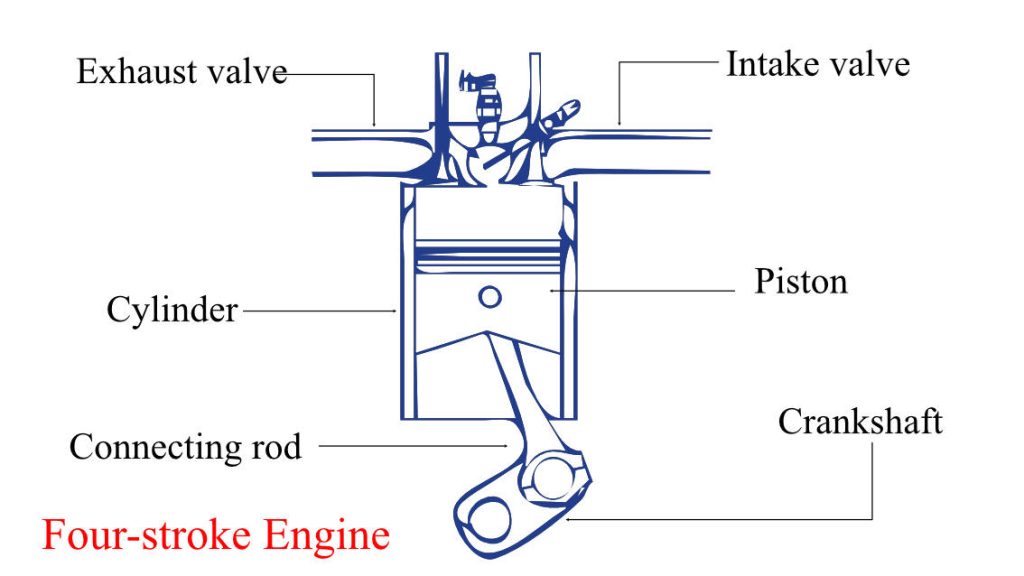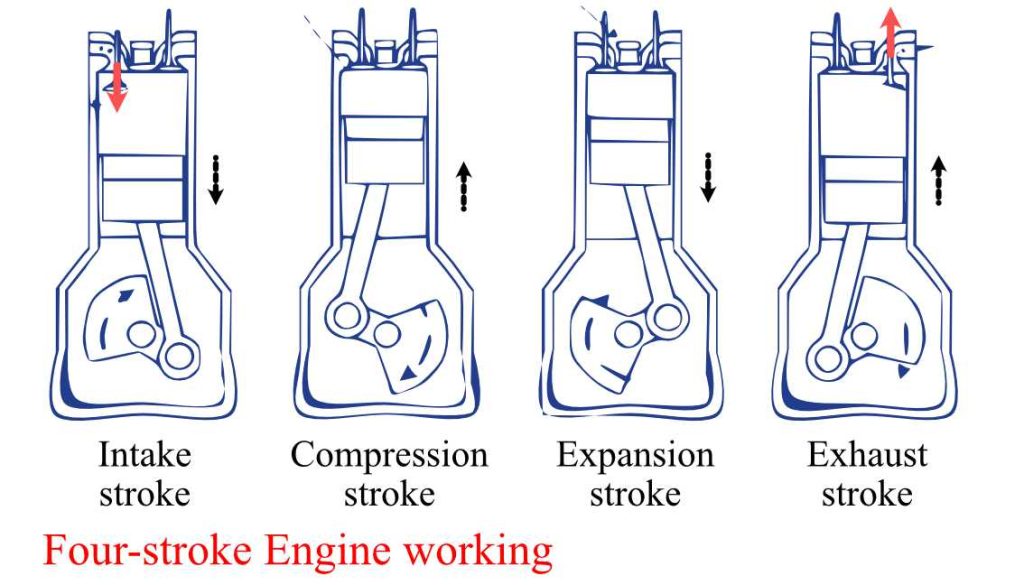Despite the belief that simple is efficient, the phrase doesn’t equate well when used for engines. Although more efficient than its two-stroke counterpart, the four-stroke engine is slightly component loaded. Let us see what exactly four-stroke engines are and see their construction and workings.
Four-stroke engine
Four-stroke engines are those internal combustions (IC) engine that travels 4strokes in 1 thermodynamic cycle to generate power.
A stroke means full travel of the piston along the cylinder. So in a four-cylinder engine, in the first stroke, the piston foes from the Bottom Dead Center (BDC) to Top Dead Center (TDC) and in the second stroke, from TDC back to BDC. This leads to one rotation of the crankshaft. When the piston covers this process twice, then it becomes 4 strokes in total. Since during all these processes, the engine generates power only once, which is why this engine got the name the four-stroke engine.
Construction of the Four-stroke engine
Understanding how these engine works require the visualization and knowledge of their construction. On the simplest level, these engines have piston-cylinder, crankshaft, valves, camshaft, and spark plug or fuel nozzle.

The components that make these engines are:
- Piston-cylinder: Like any IC engine, these also have pistons and cylinders that contain the air-fuel mixture and transfer the energy to the mechanical rotation of the crankshaft.
- Crankshaft: It converts the reciprocating motion of the piston into the rotational motion. It also helps in the compression process.
- Spark plug or fuel nozzle: In a petrol engine, the spark plug ignites the fuel-air mixture. And in diesel engines, there is a fuel nozzle in place of the spark plug, which sprays the fuel inside the cylinder.
- Valves: Valves are the openings from where the air or fuel mixture and exhaust gases move in and out of the engine. Unlike the two-stroke engine, where ports get opened and closed by the piston’s travel, the valves in these engines are controlled by the camshafts, which open and close the valves at predetermined times.
- Camshafts: It is the asymmetrical shaft with lobes present on them that opens and closes the valves. These shafts’ rotation is generated by a timing chain or timing belt connected to the crankshaft.
Working of Four-stroke engine
These engines, just like any heat engine, cover 4 thermodynamic processes in each cycle. Those four processes are carried out each stroke in the four-stroke engine.
As you already know, a stroke means. Now let us see what the strokes in these engines do:
- Intake stroke: The intake valve is opened, and the exhaust valve is closed. The piston travels from TDC to BDC, which creates a vacuum within the cylinder that draws the air or fuel mixture into the engine via the intake valve.
- Compression stroke: The valves remain closed, and the piston moves from BDC to TDC. Thus, compressing the air or fuel mixture into a small volume and thus increasing its temperature.
- Power stroke: With both the valves closed, the spark plug (in a petrol engine) ignites the compressed mixture. The resulting ignition expands the mixture, thus exerting force on the piston.
- Exhaust stroke: The final stroke is when the exhaust valve opens, and the piston moves from BDC to TDC. This piston movement pushes the exhaust gases out of the engine through exhaust valves.
At the end of the fourth stroke, the cycle completes, and the whole process restarts; this goes constantly.

To give you an idea of how fast this process occurs. A normal bike or scooter engine usually runs at around 4000 to 6000 rpm. That means 4000 to 6000 rotations of the crankshaft per minute. So in one second, the rotation of the crankshaft is
$$4000/60 = 66.6 \text{ rps}$$
Each rotation represents the completion of the above four events (strokes). As a result, in each second, the above process happens 33 times (66/2) times. Astonishing right? In F1, it further increases to 4 times this.
Difference between Four-stroke and Two-stroke engine
Apart from the simple fact that the number of strokes they cover to complete one thermodynamic cycle, these two engines have many more differences in design and working.
Difference between two-stroke and four-stroke engines:
- Valves instead of ports: In a four-stroke engine, some valves are actuated by the camshaft. Whereas the two-stroke engine has ports that the piston opens and closes.
- Separate engine oil: Instead of mixing lubricating oil with the fuel, the four-stroke engine uses a crankcase for lubricating oil storage, which doesn’t allow the mixing of lubricating oil with the fuel. This leads to a decrease in pollution and longer life of lubricating oil.
- High efficiency: The absence of scavenging and proper combustion leads to better efficiency of these engines.
- Half number of power strokes: Since this cycle completes in four strokes, i.e., 2 rotations. Therefore it gives half the number of power strokes per revolution compared with the two-stroke engine.
Advantage of 4-stroke engine
Although these four-stroke engines are a bit more sophisticated than their two-stroke counterpart. It undoubtedly has many advantages that make them highly applicable in practical applications.
Some key advantages that these engines have:
- Good fuel efficiency: Overall, these engines can provide sufficient fuel efficiency due to their design and working mythology.
- No extra addition of oil: The separate lubrication system present in these systems eliminates the need for adding engine oil to the fuel tank for the lubrication.
- Durability: The higher the contact between surfaces, the higher the wear and tear between parts will be. The 4-stroke engines are designed to work at lower rpm, thus increasing the engine’s life as there is less wear and tear.
Limitations of 4-stroke engine
These engines’ complicated and sophisticated design comes at a cost, not just complicated in design but also costlier in construction.
The areas where 4-stroke fall back is:
- Sophisticated design: The involvement of valves, timing chain, and cam-shaft is a small portion of additional parts compared to a two-stroke.
- Expensive: These engines have more parts that directly increase the cost of these engines.
Conclusions
Overall the 4-stroke engines have a long history of practical application; their higher efficiency and durability often make them the preferred choice by automobile manufacturers. To know more about their 2-stroke counterpart, you can read the previous post on the two-stroke engine.
Some key learnings from this post:
- Four-stroke engine: Four-stroke engines are internal combustion (IC) engine that travels 4 strokes in 1 thermodynamic cycle to generate power.
- Difference between four and two-stroke engines: The difference lies in their construction, working, and the number of parts they have.
- Advantage: Generally more efficient and durable with no addition of extra lubrication oil in fuel.
- Limitations: They have complicated designs and are expensive in construction because of the higher number of parts.

Android Apps
⭐️ ⭐️ ⭐️ ⭐️ ⭐️ 1000+ | 400,000 + Downloads (Cumulative)
At eigenplus, our goal is to teach civil engineering students about structural analysis and design starting from the fundamental principles. We do this with the help of interactive android applications and accompanying web articles and videos.
Our apps have helped more than 400 thousand students across the world to understand and learn the concepts of structural engineering. Check out our apps on the google play store.
Understandable and easy to learn thanks
Thank you, Jasman Kapi for your appreciation.